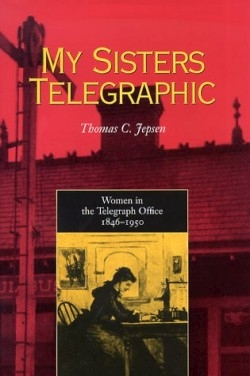It looks like you've stumbled upon a page meant to be read by our code instead of viewed directly. You're probably looking for this page.
My Sisters Telegraphic
Women in the Telegraphic Office 1846-1950
In 1870s England, male and female telegraph operators generally worked together. It was a positive arrangement, the postmaster general believed, because “it raises the tone of the male staff by confining them during many hours of the day to a decency of conversation and demeanor which is not always to be found where men alone are employed.”
It wasn’t a belief similarly held in the states, however. The author provides nuggets such as this in his treatment on the history of women and their overlooked role in the early industry of telegraphy here and abroad.
The book’s title comes from a letter published in the January, 1865, issue of Telegrapher, a publication of the National Telegraphic Union (NTU), the earliest U.S. organization founded to promote the interests of telegraphic workers.
A female worker called attention to a previous male letter-writer’s statement that women shouldn’t be admitted to the NTU. She called on her fellow female operators—“my sisters telegraphic”—to resist these gender inequities.
There were a few—which are a reoccurring theme that Jepsen, the author of several previous articles on the history of telecommunications—touches on. Working for half the pay as male counterparts and being forced to retire upon marrying are but two examples.
While there were some negative aspects, the book suggests the advent of females in the telegraphic industry actually opened up an entirely new “sphere” for the nineteenth century working woman, offering a good wage and opportunities that weren’t readily available to most women.
Writing in a chronological fashion, the author traces this history. He makes it personal and real by his use of authentic examples: “Ma” Kiley, who worked in and around the American southwest; the Mormon families who assisted with the Deseret Telegraph in Utah; and Hettie Ogle, manager of the Johnstown Pennsylvania Western Union Office, who died in the infamous 1889 flood.
Perhaps the most interesting chapter is the one concerned with the portrayal of woman telegraphers in the literature and cinema of the day. Jepsen tells of an entirely new literary genre—the “telegraphic romance”—which evolved. “Wooing by Wire” and “Wired Love” were the titles of two such popular works.
Jepsen concludes that male operators at the time “were sometimes surprised to learn that the first-class ‘man’ at the other end of the line was, in fact, a woman.”
Reviewed by
Robin Farrell Edmunds
Disclosure: This article is not an endorsement, but a review. The publisher of this book provided free copies of the book to have their book reviewed by a professional reviewer. No fee was paid by the publisher for this review. Foreword Reviews only recommends books that we love. Foreword Magazine, Inc. is disclosing this in accordance with the Federal Trade Commission’s 16 CFR, Part 255.
